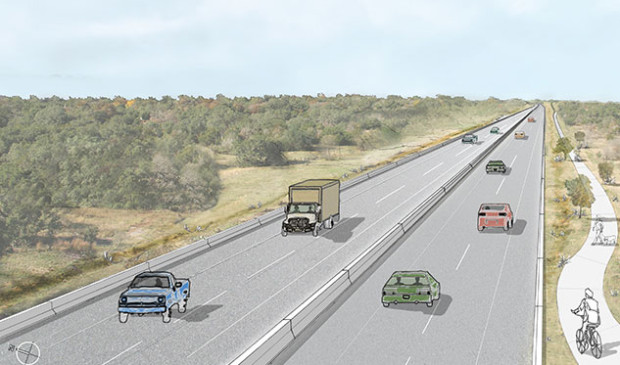CTRMA hears SH45 SW impact may be overblown
Thursday, July 2, 2015 by
Courtney Griffin While many public entities have already voiced their concerns about State Highway 45 Southwest’s possible environmental consequences, a consultant with the Central Texas Regional Mobility Authority said the anxiety might be misplaced.
At Wednesday’s regular meeting, Michael Barrett presented CTRMA’s board members with an overview of 20 years’ worth of highway stormwater runoff data in Austin.
Barrett is a University of Texas professor who specializes in environmental and water resource engineering. He also is employed as a CTRMA consultant and contracts with the Texas Commission on Environmental Quality.
Barrett said much of the SH45 SW debate revolves around differing regulatory requirements for the Barton Springs Zone, which includes land surrounding the potential road.
For the project, CTRMA is slightly exceeding the state law requirement that 80 percent of total suspended solids be removed from the road’s rainfall runoff, he said.
Total suspended solids, or TSS, are solids in water that can be trapped by a filter. TSS can include a wide variety of material, such as silt, decaying plant and animal matter, industrial wastes and sewage. High concentrations of suspended solids can cause many problems for stream health and aquatic life.
The state, or TCEQ, requirements for TSS removal are known as the Edwards Aquifer Rules.
Many critics want the project held to stricter, local standards, which are derived from the 1992 voter-adopted Save Our Springs ordinance. It is a nondegradation ordinance requiring that the annual average of multiple pollutant levels remains the same as (or lower than) the pre-development average.
Barrett said there is a regulatory “disconnect” with both the Edwards Aquifer Rules and the SOS ordinance, however.
Neither regulatory calculation directly measures the pollutant concentrations that directly harm species, he said. Instead the regulations focus on “load,” which is the amount of a pollutant discharged into a volume of water during a period of time.
“The challenge is (that) when we do the same (load) calculation post-development, the runoff volume part goes up by a factor of 10 or 20,” Barrett said. “The more you pave, the less water soaks into the ground; more runs off.”
This greater volume of water makes adherence to SOS tricky. The calculation requires that stormwater runoff have no impact on the surrounding environment. As such, if there is 10 percent more water running off, even with the same amount of pollutants present as before development, builders have violated the ordinance, Barrett said.
“So, that’s how SOS ends up being a no-discharge strategy. We’re going to capture it (the runoff), and we are going to have a mechanical system with electronic controllers and pumps,” Barrett said.
CTRMA would be required to capture and treat an estimated 475,000 cubic-feet of water for SH45 SW, he said. To accomplish this, the agency would maintain a retention pond and irrigation system that, like any machine, could break down, he noted.
According to the city of Austin’s own reports, Barrett said pollutants associated with highway runoff have remained level or even decreased in the past 20 years.
TSS levels – measured in milligrams per liter – have roughly remained the same since 1995, and zinc levels, which come mainly from tires, have decreased since 1995, he said.
“This is what nondegradation looks like in the aquifer,” Barrett said. “A lot of the development happened under the Edwards Rules, not under SOS. So, you’d think if the Edwards Rules were not sufficient to protect water quality, you’d at least see a gradual trend increase in total suspended solids.”
Barrett said that more measurable harm to the aquifer can be traced from an increase in wastewater from added septic tanks in the area. The Barton Springs Zone has added 80,000 residents in the past 10 years, he said.
Nevertheless, CTRMA Director David Armbrust said that regardless of whether Barrett agrees with it, “SOS is a community standard. … So, when we start talking about building SH45 SW, my default position is: We should be complying with SOS.”
Barrett responded by pointing out that complying with SOS would require CTRMA to implement a retention-irrigation option that needs a hefty mechanical system, “which exists nowhere in the United States.” The state law allows for more natural stormwater runoff options while still avoiding high pollutant concentrations, he said.
The presentation was an information item given during Wednesday’s Executive Director’s Report.
Conceptual rendering from sh45sw.com.
You're a community leader
And we’re honored you look to us for serious, in-depth news. You know a strong community needs local and dedicated watchdog reporting. We’re here for you and that won’t change. Now will you take the powerful next step and support our nonprofit news organization?







